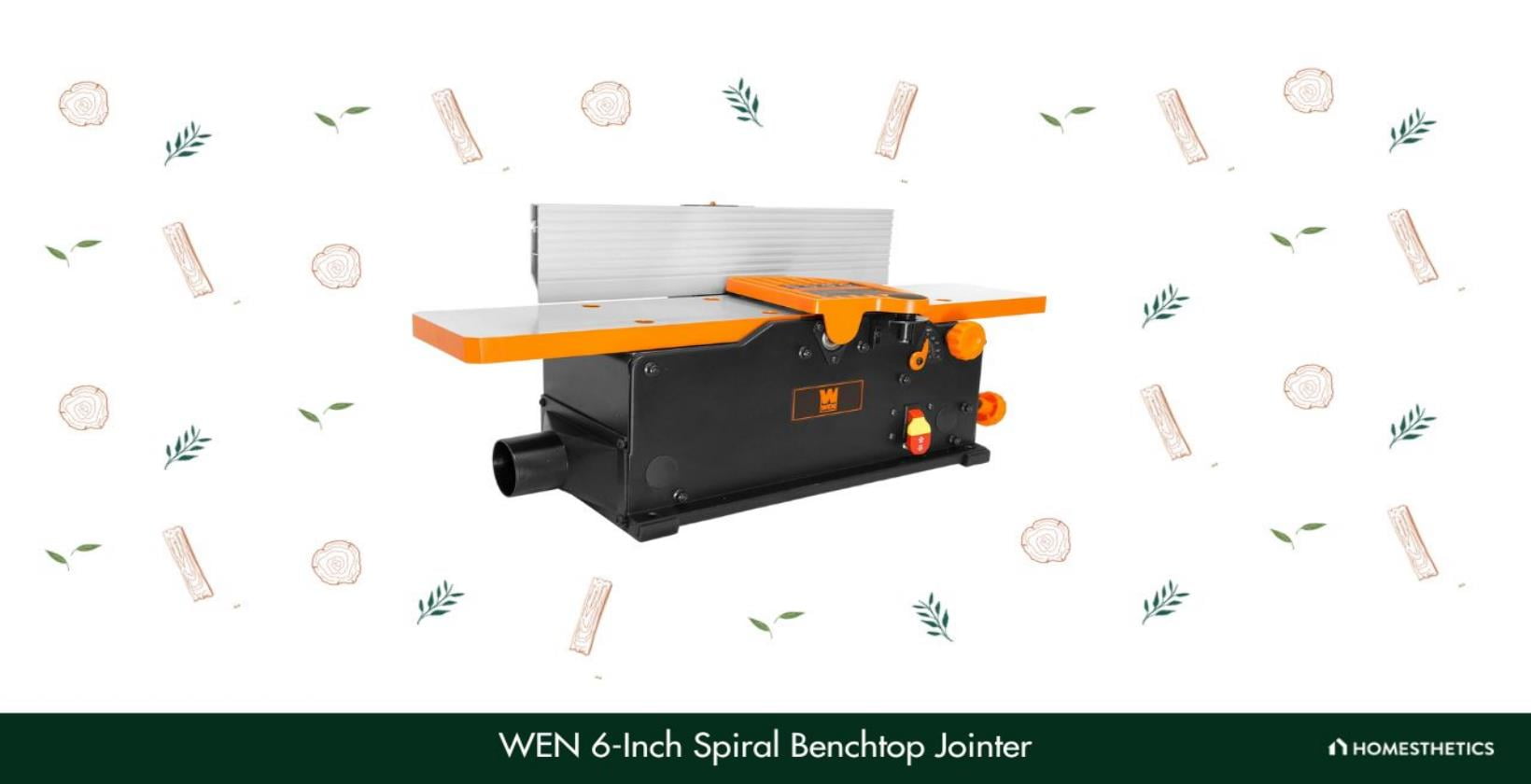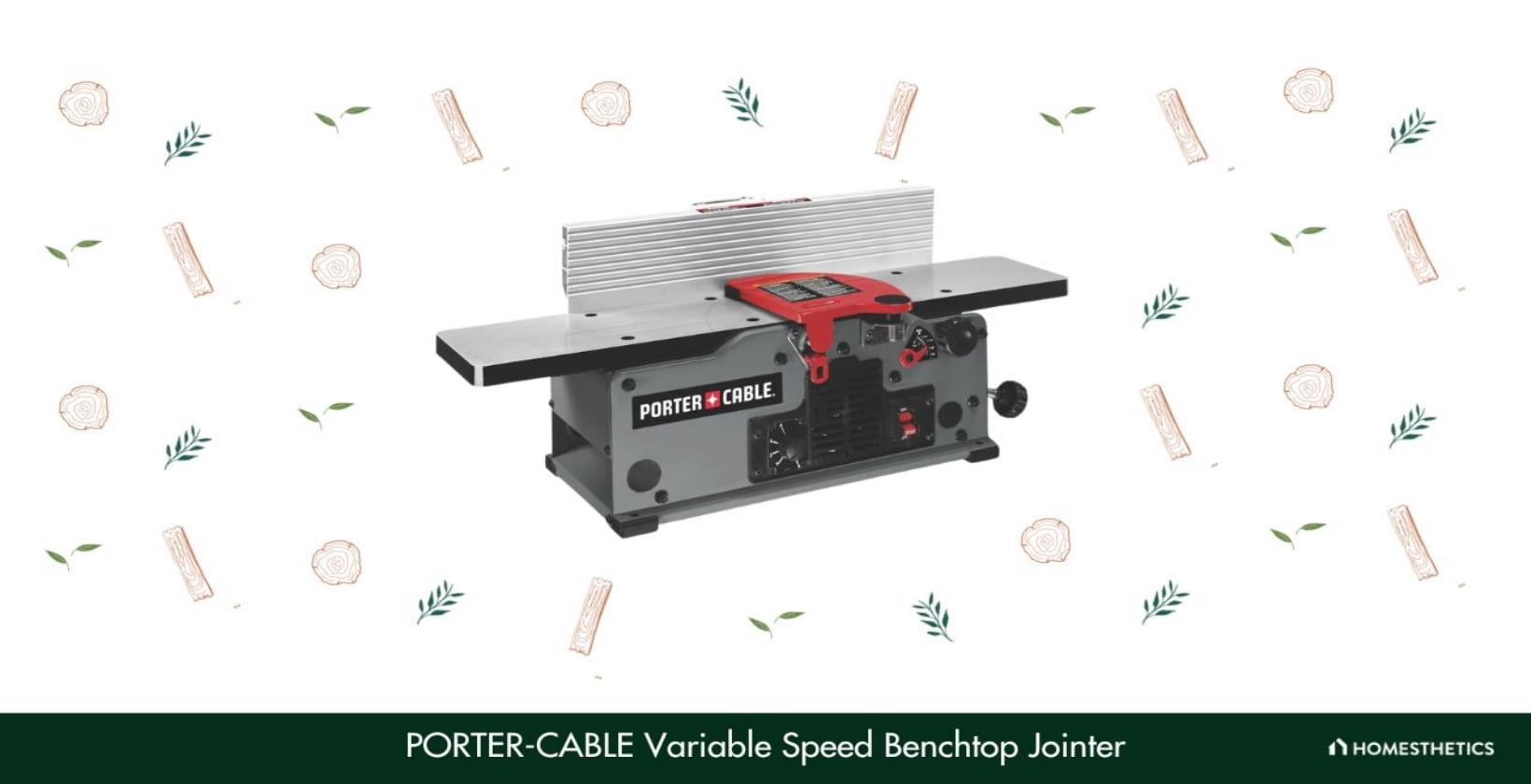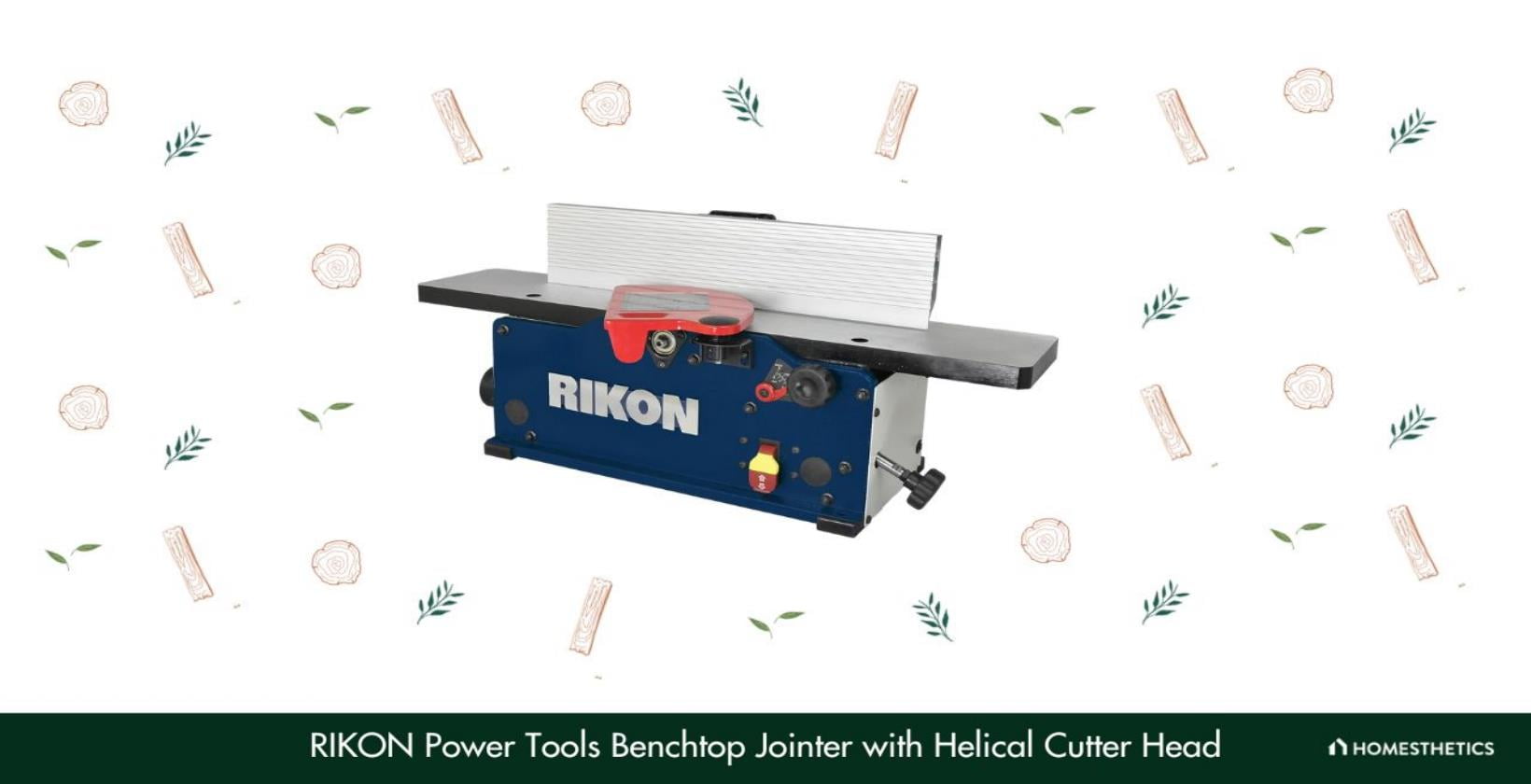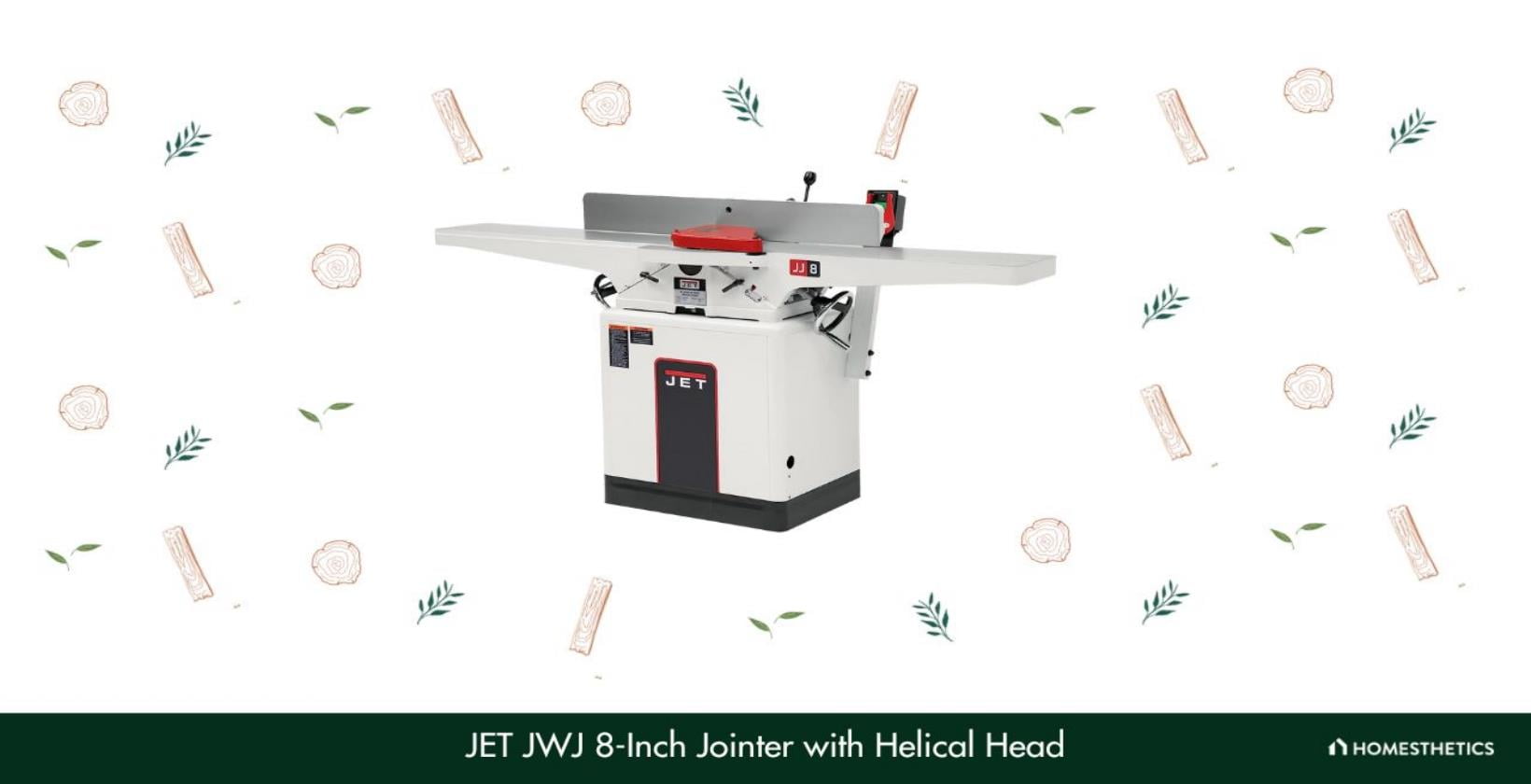When it comes to the best budget jointer that are do-it-yourself, some of the top names include the Wen 6-inch spiral benchtop jointer and the PORTER-CABLE variable speed benchtop jointer. These machines can provide professional-grade finishes and are easy to use for all skill levels.
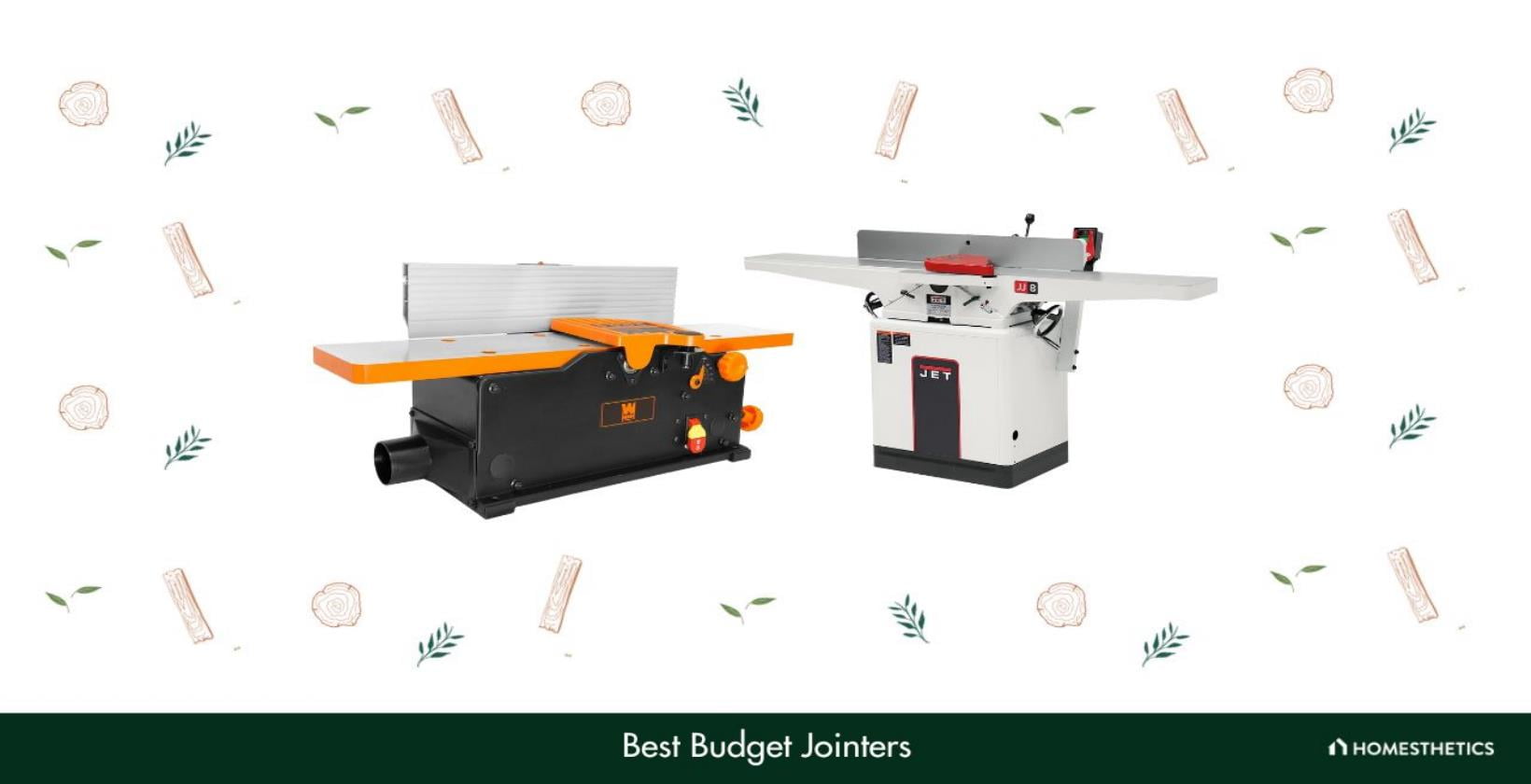
Whether you’re a hobbyist woodworker or indulge in DIY wood projects for your home, a wood jointer can be the perfect tool to prepare the wood. And you will find many benchtop options on the market that won’t burn a hole in your pocket! So, I am here today to help you make the right choice by reviewing the 5 best budget jointers that are easy on the pocket. Dive in!
Explore these wood jointers ideal for home projects at a glance:
- WEN 6-inch spiral benchtop jointer: The WEN's 6-inch spiral benchtop jointer delivers fast motor speed for hard and softwood. Fueled by a 10-amp motor, it features a spiral cutterhead with 12 HSS blades for precision. Convenience is enhanced with a blade guard, push blocks, and a dust port, although achieving square cuts can be challenging.
- PORTER-CABLE variable speed benchtop jointer: The PORTER-CABLE's portable variable speed benchtop jointer, weighing 35 pounds, boasts a variable speed motor (6,000 to 11,000 RPM). Its sharp two-knife cutterhead and center-mounted fence ensure smooth and precise cuts. Drawbacks include the absence of a dedicated blade guard and a challenging knife replacement mechanism.
- Rikon Power Tools benchtop jointer: The Rikon Power Tools' benchtop jointer features a durable helical cutterhead with 12 HSS blades and a high-speed steel knife. The adjustable fence, depth mechanism, and a 30 x 6-3/16 inches work table cater to various woodworking tasks. Safety features include a spring-loaded guard and push blocks, though the sharp fence poses injury risks.
- JET JWJ 8-inch jointer with helical head: The JET's JWJ 8-inch jointer with helical head, designed for heavy-duty work, sports larger 8-inch infeed and outfeed tables. Powered by a 2 HP motor, it allows easy adjustment for versatile cutting depth. The two-way tilt fence enhances cutting precision, but it lacks an adjustable speed mechanism.
- JET JJ 6-inch helical head benchtop jointer: The JET's JJ 6-inch helical head benchtop jointer is an affordable option for DIY woodworking. With a 1 HP motor and 14 carbide blades, it ensures ample power and efficiency. The cast iron construction guarantees durability, and the tiltable fence allows cuts from different angles. Challenges include a blower-equipped motor dispersing sawdust and a complex fence-locking mechanism.
1. Best for easy operation - WEN 6-inch spiral benchtop jointer
What We Like
- Fast motor speed
- Suitable for hard and soft wood
- 12 HSS blades and blade guard
- Comes with push blocks and dust port for enhanced convenience
What We Don't Like
- Getting square cuts can be somewhat challenging
When it comes to woodwork tools and machines, WEN is one name that has been preferred by both novices and professionals. And this budget jointer from the brand justifies this reputation to a large extent.
Featuring a spacious 30 by 6 inches worktable, this unit can be suitable for light to medium-duty woodworking in your workshop or garage. It’s powered by a durable 10-amp motor that supports the spiral cutterhead to rotate for up to 12,000 times per minute for speed.
At the same time, the 12 HSS blades on the cutterhead take care of precision finishing. And the spring-loaded blade guard minimizes injury risks by exposing only a small portion of the blade.
While testing the jointer, I found that it accommodates both soft and hardwood. Aside from that, the adjustable infeed table can remove anywhere from 0 to ⅛-inch of wood with every pass, and the depth-of-scale on offer accounts for accuracy. Not only that, but you can also tilt the fence by up to 45 degrees to make angled cuts on the face of the wooden board.
However, you may have to tape the workpiece heavily (especially if it’s on the thicker side) to make it sit flush with the fence to get precise square edges.
2. Best for portability - PORTER-CABLE variable speed benchtop jointer
What We Like
- Variable speed motor
- Sharp and adjustable two-knife cutterhead
- Blade replacement facility for uninterrupted operation
- Large work surface and center-mounted blade
What We Don't Like
- No dedicated blade guard
- Difficult knife replacement mechanism
If you’re looking for a benchtop jointer that’s easily portable, this unit from Porter-Cable may be worth considering. Weighing around 35 pounds, its compact design can fit in your work truck or car without taking up too much space.
Like its predecessor, this benchtop jointer runs on a 10-amp motor. However, its variable speed range facilitates 6,000 to 11,000 RPM (revolutions per minute), meaning you can achieve 12,000 to 22,000 cuts per minute, depending on the speed.
You can adjust the speed by rotating the knob at the base of the jointer, choosing a number from 1 (lowest) to 5 (highest). As a result, it becomes pretty versatile for different types of cuts and finishes on wooden boards up to 6 inches thick.
Coming to the ‘main element’ of the unit, the sharp two-knife cutterhead makes smooth and precise cuts. Moreover, it has a jackscrew knife leveling arrangement for blade adjustment and replacement, and the in-built cutter lock secures the blade for safety.
But after putting the cutter to the test, I felt that a blade guard would have done a better job of ensuring safety, especially when working at high speed. Besides, replacing the knife can be challenging for first-time users.
Lastly, the center-mounted fence aids the long flat work surface so that it can seamlessly accommodate larger and thicker boards.
3. Best for hardwood jointing - RIKON Power Tools benchtop jointer with helical cutterhead
What We Like
- Sharp and durable helical cutterhead
- High-speed metal knife
- Adjustable fence and depth mechanism
- Dust port for easy dust collection
- Safety gear included
What We Don't Like
- Sharp fence may cause injuries
The Rikon Power Tools benchtop jointer features a distinguishing helical cutterhead, which, the brand claims, can deliver superior cutting speed. For the unversed, helical cutterheads are known to retain their sharpness for longer than other types of jointer blades. Hence, this unit can fit the bill for you if you work with thicker wooden boards frequently.
Not only that, but it can also save you from the hassle of replacing the blade frequently.
Further, the cutter has 12 HSS blades, 2 insert cutters, and a high-speed steel knife that pairs with the 10-amp motor for accuracy and precision without compromising speed. And with a work table measuring 30 x 6-3/16 inches, it can accommodate longer boards without much issue.
The jointer itself is made of machined aluminum construction for enhanced durability with regular use, especially in areas like workshops or garages. Moreover, the depth adjustment mechanism has a scale for precise setting, and the bevel fence has a tilt range of 45 to 90 degrees for making angled cuts.
Talking about the safety measures, it has a familiar spring-loaded safety guard and two push blocks. But I felt that the fence was too sharp, and no means of covering it could result in injuries if you aren’t careful.
Lastly, after checking the packaging, I also found a ½-inch dust port that helped keep my makeshift workshop clean.
4. Best for heavy-duty work - JET JWJ 8-inch jointer with helical head
What We Like
- 2 HP motor for more power
- Easy adjustment for versatile cutting depth
- Two-way tilt fence
- Large and flat infeed and outfeed table
What We Don't Like
- Lacks adjustable speed mechanism
After testing one helical head cutter wood jointer, I wanted to try another one to see how it fairs, which is when I came across this model. And as you may have already figured out, it’s a ‘standout’ from the rest of the products so far owing to its larger infeed and outfeed tables (8-inch). As such, I feel it will be best suited for heavy-duty carpentry work like cabinetry.
Now, talking about its specifications, this machine runs on a 2 HP motor that looks pretty promising. Besides, the cutting head has indexable tungsten carbide insights that can make precision cuts with low noise and vibration output.
Additionally, the sharpness of the cutter means finer cuts without inflicting too much damage on the wood’s surface. So, you won’t have to spend much time achieving a smoother finish later. You can also adjust the cutterhead to change the cutting depth as and when required, according to the depth and thickness of the wood.
The two-way tilting fence is another feature that can help you get smooth cuts, with positive stops designed at 45 and 90 degrees. And the attached dust chute makes cleaning sawdust a breeze.
But with all said and done, I feel this machine could have an adjustable speed mechanism for its price.
5. Best for do-it-yourself woodworking - JET JJ 6-inch helical head benchtop jointer
What We Like
- 14 carbide blades
- Cast iron table and fence
- Removable safety key
- Visible depth scale
What We Don't Like
- Blower-equipped motor can spear sawdust all over
- Fence-locking mechanism is hard to understand
Before concluding the list, I have another benchtop jointer from the house of JET, this time something more affordable and suitable for DIY work.
This 6-inch model can be considered an earlier version of the 8-inch one, and it’s powered by a 1 HP motor, which still has more than enough power for DIY woodworking. Plus, the 14 indexable 4-sided carbide blades can take on more material at a time, reducing the time and effort required for smooth cuts.
The machine boasts a cast iron construction, preventing it from damage caused by regular use. And the spacious infeed and outfeed surfaces can securely accommodate larger wooden boards (not more than 6 inches, though).
Like most other products on my list, it has a tiltable fence with lock stops at +/-45-degree to aid you in making cuts from different angles. However, it did take some trial and error to figure out the locking mechanism on this one. And although the blower-equipped motor moves sawdust away from the motor and cutting head, it can sometimes blow dust in the surrounding area.
Apart from that, the prominent scale for depth adjustment can come in handy for fast and easy monitoring. And the front-mounted toggle switch has a removal safety key for a quick stop during an emergency.
What are the best budget jointers available for home woodworking?
Below is a table that lists the best jointers for DIY home projects on woodworking. It provides comparisons of various factors, including cutting width, motor power, cutterhead design, table length, adjustability, dust collection, and other safety features.
| Jointers | Type | Cutting Width | Motor Power | Cutterhead Design | Table Length | Adjustability and Fence | Dust Collection | Safety Features |
|---|---|---|---|---|---|---|---|---|
| WEN Benchtop Jointer | Benchtop | 6" | 1.6 HP | Spiral | 30" | Bevels up to 45° | 2.5" onboard dust port | Push blocks, spring-loaded blade guard |
| PORTER-CABLE Benchtop Jointer | Benchtop | 6" | Around 1.3 to 1.5 HP | Two-knife | 30" | Can be moved across the table, tilts up to 45° | Built-in dust collection port | Push blocks, cutterhead guard, built-in cutterhead lock |
| RIKON Power Tools Benchtop Jointer | Benchtop | 6" | Around 1.3 to 1.5 HP | Helical | 30'' | Tilts from 90° to 45° | 2.5" dust port | Front safety on/off switch, spring-loaded safety guard, push blocks |
| JET JWJ-8HH | Freestanding | 8" | 2 HP | Helical | 72" | Tilts two-way | Built-in 4" dust chute | Cutterhead guard |
| JET JJ-6HHBT | Benchtop | 6" | 1 HP | Helical | 28.6" | Tilts 45° | Internal dust collection system | Push block, push stick |
Budget jointers buying guide
Well, knowing only the ‘budget’ for getting the best budget jointer is only the job half done. You should also be aware of some other important factors to ensure that you get the right unit for your needs.
Some of them are as follows:
1. Build quality
Although a lot of people think that the durability of a jointer is determined by things like the motor strength and the blade quality, the build material of the jointer is also important. As such, the best jointers are typically made of a robust material like aluminum or cast iron for reduced wear and tear with frequent use. Although they cost slightly more money, they will provide better longevity.
2. Motor
The motor of a jointer is directly related to the speed of woodworking jointers- a powerful motor will spin more rapidly, allowing you to get the job done with fewer passes. Moreover, a high-quality motor will not heat up and wear down as quickly, thereby prolonging the life of the machine.
From what I have seen, most DIY jointers come with 10-amp motor power capable of 10,000 or more rotations per minute, so you can use that as a starting point. Of course, more powerful machines will come with ‘stronger’ motors.
Another thing to keep in mind here is that some jointers come with a variable speed motor, where you can change the speed at which the blades operate. This will help achieve the desired finish according to the thickness of the wood.
3. Table width
The table size of your preferred jointer will indicate the width of the wooden board you can work with at a given time. Most benchtop jointers meant for DIY or light to medium-duty woodwork have a depth of 6 to 8 inches, while the more professional ones come with wider tables.
Aside from that, you should ensure that the infeed and outfeed tables have flat surfaces to hold the workpiece properly when you’re working on it.
4. Adjustable fence
The fence is the part of the jointer that holds the wood flush to the blade, and an adjustable fence means you can alter the way the angle of the cuts. The jointers I have tried so far can be adjusted to make angular cuts at 45 to 90-degree angles. They also come with some sort of locking mechanism to keep the board in place.
Now, this may seem like a ‘fancy’ feature, but it doesn’t really add anything to the cost of the jointer. Besides, an adjustable fence can make room for future requirements, especially for furniture making.
5. Type of blade
Woodworking tools like jointers and planers are generally equipped with a straight, circular, or helical blade.
Straight blades are more commonplace, especially in beginner-friendly jointers. These straight and long blades provide smooth finishes as well as easy to work with and replace. However, spiral blades, despite being one continuous piece of metal, are equipped with cutting inserts, looking much like the jaw of a piranha.
They take off small amounts of wood at one time and can often be rotated (in the case of 2 or 4-sided blades). Helical blades, on the other hand, are a ‘premium’ variant attached to a specialized cutterhead. They are basically inserts placed close to one another in a helical pattern.
Helical blades offer better finishes and cuts, making them more suitable for professional carpentry. Additionally, they may be paired with metal knives for better accuracy and speed.
All types of blades can be replaced, and you will find the instructions in the package itself. But it can take you some time to get the hang of the process if you don’t have the required experience.
6. Additional accessories
Wooden jointers almost always come with safety accessories like push blocks and blade guards. The latter may be attached to the blade, or you may have to install it yourself. Additionally, they may come with a removable or integrated dust chute for sawdust collection.
What can a benchtop jointer be used for?
A benchtop jointer can be used for various purposes like:
- Straightening the edges of lumber for furniture-making
- Trimming wooden boards
- Flattening the surface or face of wooden boards
- Providing a smooth finish to the board for correcting defects
Besides, the type of jointer you choose will determine its usability to a large extent. For example, a benchtop jointer is generally considered a better option for DIY woodwork or carpentry involving softwood. However, a standing jointer is a heavy-duty option that can work well for frequent hardwood work.
How to use a benchtop jointer properly?
Using a benchtop or workbench jointer properly involves holding the wooden board properly on the fence so that it sits flush with the cutter (blade). But before that, make sure you’ve selected all the right settings in terms of the motor speed (if applicable), cutting depth, and fence angle.
You should also take care of safety measures like using push blocks and engaging the blade guard.
What is the difference between a jointer and a wood planer?
The major difference between a jointer and a planer is the purpose of use. While a jointer is used to straighten or flatten the edges of the lumbar, a planer is meant to alter its thickness. It mainly comprises a work surface (flat table) and rotating blade cutters.
Once you feed the wood through the table, the blades take off material from the wood to give you the required thickness and a smooth surface. You can read more about stationary wood planers in my article.
What are some additional measures you can take while working on a jointer?
Some additional measures you can take while working on a jointer are - always work under bright lights so that you can keep your hands away from the blade and fence without losing grip on the wood. And wear safety gloves for enhanced hand protection. You should also wear a dust mask and work goggles to keep sawdust at bay.
So, which budget jointer should you buy?
For me, it’s the (drumrolls) WEN 6-inch spiral benchtop jointer that takes first place. Despite being one of the more affordable machines, it can offer quality cuts and finishes for all your wooden projects, no matter your skill level. But, you can also try the PORTER-CABLE variable speed benchtop jointer for a step up in versatility.
If you liked this read, check out my other one on the best benchtop planer or best molding planer. Keep an eye on this space - I will see you another day!

